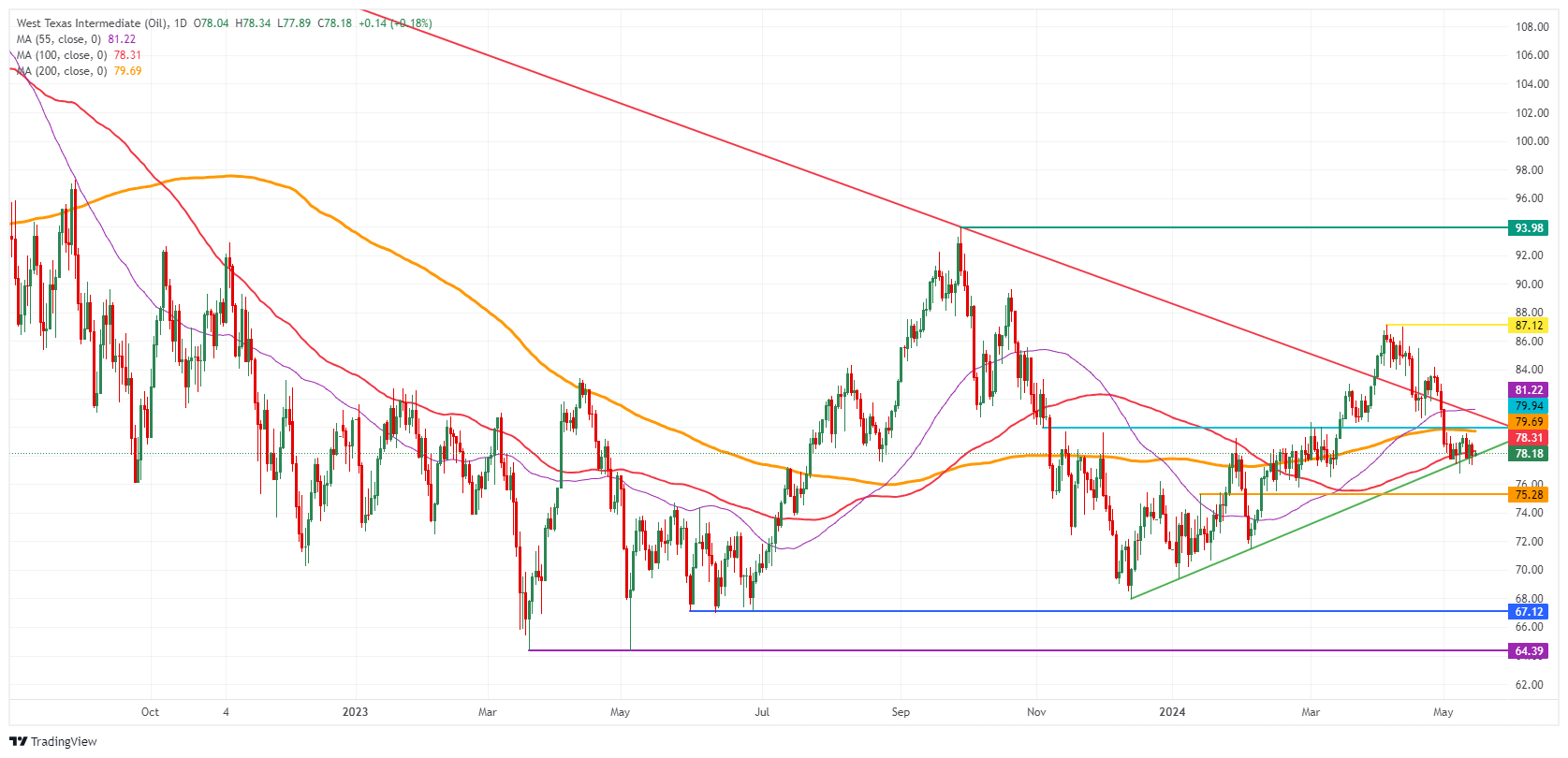- Oil falls below $78 following the publication of monthly OPEC and IEA reports.
- While OPEC maintained its expectations, the EIA predicted a drop in demand.
- US Dollar Index weakens ahead of CPI release.
Oil prices fall below $78 on Wednesday after mounting bearish pressure became too great considering all the elements on the table right now. In addition to the fragile balance in the Middle East and the Red Sea, the latest reports from OPEC and the International Energy Administration (IEA) also do not offer a clear picture: the EIA has cut its oil demand forecasts and OPEC maintains its expectations previous. As if the outlook wasn't blurry enough, the US Federal Reserve's (Fed) stance on maintaining interest rates for longer is postponing the initial cut, which would mean an increase in demand.
Meanwhile, the US Dollar Index (DXY) retreats below 105.00 ahead of the release of the Consumer Price Index (CPI). Markets seem convinced that the figure will be lower than expected, after Tuesday's release of the Producer Price Index (PPI) saw a widespread downward revision in both the core and overall PPI. Operators expect weaker data, so an unexpected rise in inflation would cause chaos in the markets and a predominance of the Dollar at the end of the day.
At the time of writing, crude oil (WTI) is trading at $77.27 and Brent crude oil is trading at $82.30.
Oil news and market movements: EIA figures
- Ahead of the next OPEC meeting, the group has ordered an external review to find out how much capacity each member has, Bloomberg reports.
- Mexico has lowered Mayan oil prices for Gulf Coast refineries, Reuters reports.
- The IEA reports that global consumption will increase by 1.1 million barrels per day this year, which is 140,000 barrels less than expected a month ago.
- At 14:30 GMT the Energy Information Administration will publish weekly changes in US crude oil reserves. Previously, there was a reduction of 1.362 million barrels and another reduction of 1.35 million barrels is expected this week.
Oil technical analysis: This could get ugly
Oil prices are about to crack under pressure with the Federal Reserve's stance to maintain interest rates for longer. Fed Chairman Jerome Powell reconfirmed this stance on Tuesday during a speech in Amsterdam. This means that the rebound in US demand will not occur until after the summer at the earliest, so crude oil is not likely to break above substantial pivotal levels as long as demand does not exceed supply.
To the upside, the line in the sand remains at $79.73 with the 200-day SMA. Once above that level, a double layer appears with the 100-day SMA at $78.23. In case of an upward extension above that zone, the path opens again towards $87.12.
To the downside, the pivotal level at $75.28 is the last solid line in the sand that could end this decline. If this level does not hold, investors could expect accelerated selling towards $72.00 and $70.00. This would wipe out all gains by 2024 and then the oil price could test $68, the December 13 low.

WTI Crude Oil: Daily Chart
WTI Oil FAQ
What is WTI oil?
WTI oil is a type of crude oil that is sold in international markets. WTI stands for West Texas Intermediate, one of the three main types that include Brent and Dubai crude. WTI is also known as “light” and “sweet” for its relatively low gravity and sulfur content, respectively. It is considered a high-quality oil that is easily refined. It is sourced in the United States and distributed through the Cushing facility, considered “the pipeline junction of the world.” It is a benchmark for the oil market and the price of WTI is frequently quoted in the media.
What factors determine the price of WTI oil?
Like all assets, supply and demand are the main factors that determine the price of WTI oil. As such, global growth can be a driver of increased demand and vice versa in the case of weak global growth. Political instability, wars and sanctions can alter supply and impact prices. The decisions of OPEC, a group of large oil-producing countries, is another key price factor. The value of the US Dollar influences the price of WTI crude oil, as oil is primarily traded in US dollars, so a weaker Dollar can make oil more affordable and vice versa.
How do inventories influence the price of WTI oil?
Weekly oil inventory reports published by the American Petroleum Institute (API) and the Energy Information Agency (EIA) influence the price of WTI oil. Changes in inventories reflect the fluctuation of supply and demand. If the data shows a decline in inventories, it may indicate an increase in demand, which would drive up the price of oil. An increase in inventories can reflect an increase in supply, which drives down prices. The API report is published every Tuesday and the EIA report the next day. Their results are usually similar, with a difference of 1% between them 75% of the time. EIA data is considered more reliable since it is a government agency.
How does OPEC influence the price of WTI oil?
OPEC (Organization of the Petroleum Exporting Countries) is a group of 13 oil-producing nations that collectively decide member countries' production quotas at biannual meetings. Their decisions often influence WTI oil prices. When OPEC decides to reduce quotas, it can restrict supply and drive up oil prices. When OPEC increases production, the opposite effect occurs. OPEC+ is an expanded group that includes ten other non-OPEC member countries, including Russia.
Source: Fx Street
I am Joshua Winder, a senior-level journalist and editor at World Stock Market. I specialize in covering news related to the stock market and economic trends. With more than 8 years of experience in this field, I have become an expert in financial reporting.







